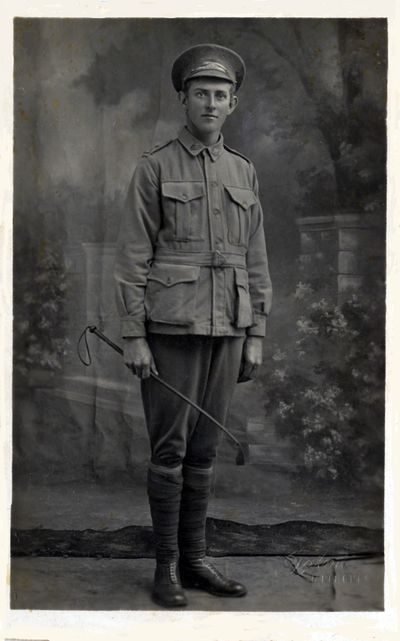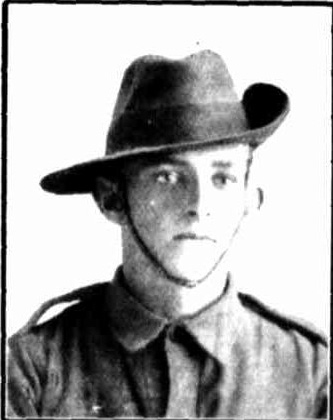Difference between revisions of "John Edward Thomson"
From Our Contribution
| Line 155: | Line 155: | ||
[[Category:Returned to Australia]] | [[Category:Returned to Australia]] | ||
[[Category:Armadale Memorial]] | [[Category:Armadale Memorial]] | ||
| + | [[Category:Born Victoria]] | ||
[[Category:Church of England]] | [[Category:Church of England]] | ||
[[Category:Brickmaker]] | [[Category:Brickmaker]] | ||
Revision as of 13:09, 22 August 2017
 Courtesy of Helen mason | |
 Western mail 15 Jun 1917 p.43 | |
| Personal Information | |
|---|---|
| Date of Birth | 12 Jun 1892 |
| Place of Birth | Brunswick, Victoria |
| Death | 13 Jun 1938 |
| Place of Death | Armadale, Western Australia |
| Age at Enlistment | 23 years old |
| Description | 5' 9 1/4" (1.76m) tall; weight 147 lbs (66.7 kg); reddish complexion, blue eyes and has a scar on the back of his right leg. |
| Occupation | brickmaker |
| Religion | Church of England |
| Address | NOK 52 Stone street, West Perth, Western Australia |
| Next of Kin | Mother Mrs Elizabeth Fox |
| Military Information | |
| Reg Number | 383 |
| Date of Enlistment | 3 Jul 1915 |
| Rank | Corporal |
| Unit/Formation | 31st Battalion, B Company / 8th Brigade, 5th Division |
| Date of Embarkation | 9 Nov 1915 - 6 Dec 1915 |
| Ship Embarked On | HMAT A62 Wandilla |
| Date of Return | 29 Nov 1918 - 5 Jan 1919 |
| Ship Returned On | HMAT A29 Suevic |
| Fate |
Wounded in Action 26 Sep 1917 at Polygon Wood Wounded in Action 8 Aug 1918 at Amiens Returned to Australia |
| Monument | Armadale (Beenup panel) |
| Medals |
1914-15 Star British War Medal Victory Medal |
Pre War
War Service
Posted during early training at Enoggera (Brisbane) to B Company of the newly formed 31st Battalion. His company and A Company travel by rail to Broadmeadows in Victoria on 3 Oct 1915. For the rest of the month they undergo more complex training, before along with other units of the 8th Brigade they sail on 9 Nov 1915 for Egypt, via Perth, arriving in Port Suez on 6 Dec 1915.
Their initial camp was at Heliopolis on the outskirts of Cairo where they trained while waiting for the Gallipoli evacuees to join them.
With Turkish intentions of attacking Egypt via the Sinai Peninsula evident, they were moved to Serapeum where they spent until June 1916 in defensive positions, protecting the Suez Canal before they were transported by train to Alexandria where they boarded HMAT A20 Hororata on 15th June. They sailed on 17th June with other elements of the 8th Brigade, arriving at Marseilles late on the 22nd. During their time in the Sinai John spent a month in hospital at Tel-el-Kebir with mumps.
On arrival in France they were transported to the Western Front by rail wagons, averaging just over 5 miles (8 km) per hour by way of Avignon, Lyon, Amiens, Abbeville, Étaples, Boulogne, Calais and Hazenbrouck. They arrived in Steenbecque on June 26th.
Following familiarisation they entered the front lines for the first time on the 11th July near Fleurbaix and on the 19th July 1916, fought in the first major battle involving Australians on the Western front at Fromelles. The Battalion suffered 572 casualties, over half of its strength. On 30 Jul 1916 John reports ill and is sent off for a break.
John wrote home to his sister on the 2nd August from a rest camp,
“I have been simply a wreck, nerves and all shakes, frightened to go to sleep at night because of dreams of some of the awful sights I saw and experienced and I never want to go through the likes again”. He also wrote of “being well treated, the best of food, fruit, custard, jellies, poultry etc. galore. Hot bath whenever we want it with a change of clean underclothing, nothing to do all day but what suits ourselves.”
John rejoined the Battalion on 17 Aug 1916, and spendt the next seven months with the unit.
On 13 Mar 1917 John travels to England on the HS Stad Antwerpen from Calais and was admitted to the Clacton-on-Sea Hospital suffering from exhaustion. A month later he is discharged and given a fortnight's leave in England, before rejoining his battalion.
As the British advanced in 1917 the 31st Battalion largely participated in follow-up operations. The only major battle that year was at Polygon Wood on the 26th September where John was wounded in action in the left foot and again returned to England on HMHS Western Australia where he was admitted to the City of London Military Hospital, Clapton.
He was discharged on 29 Dec 1917 and moved to Hurdcott, a Group Clearing Hospital, staffed by Australian Medical Services where thousands of Australian wounded were treated and he remained there until 20th March, 1918 when he again returned to France.
In 1918, the 31st Battalion was largely kept in reserve, however, they participated in the Battle of Amiens on the 8th August where John was again wounded in the left foot. He was hospitalised and returned to England and admitted to the Endell Street Military Hospital before being transferred to Littlemoor Camp, Weymouth on the 9th September, then hospitalised again until the end of September.
Post War
While born in Australia to British immigrants, the family was returning to Scotland in 1894 when John's father (James) died during the trip of typhus.
Back in London, John's mother undertook midwifery training while John and his sister were cared for by her family in Scotland.
They again emigrated to WA in June 1895, and in 1896 Elizabeth married again, this time to John Patrick Fox, who later abandoned the family. The family was forced to live in a single room in Wellington street, Perth and their only food was the meagre government rations 400gms of tea, 700 gms of meat, and 8 loaves of bread a week between Elizabeth and four children.
John was separated from the family and was in NSW in 1907, before returning to WA (Narrogin) in 1909. By 1915 he was a brickmaker at the Beenup brickworks. Despite this, for whatever reason he enlisted in Ipswich Qld, but gave his mother's address as his normal place of residence.
On his return from the war, the Beenup community presented John with an inscribed shield for Services to King and Country. John resumed employment at the Brickworks and on the 9th August 1920, married Mary Baillie Reid whom he had met in Scotland during the war while on furlough visiting his father’s relatives. Mary was from West Calder and was born on the 13th August 1890.
On the 10th May 1921, James Alexander Thomson was born, followed by John Thomas Thomson in 1923 and Margaret in 1926. The family travelled to Scotland in 1930 to visit both Mary and John’s relatives, and while there Margaret tragically died of pneumonia, aged 3½ years. Letters to Elizabeth and Catherine from the Thomson relatives tell of their heartbreak and also mention that John had been given 3 months paid leave from the Brickworks. He also had to borrow money from an aunt, 20 pounds, for a headstone.
The family continued to live at Byford and John worked at the brickworks. He was a member of several organisations including the Armadale Sub-branch of the Returned Soldiers League, a member of Armadale Lodge or Oddfellows and a member of the Brickmakers and Pottery Workers Union.
In 1934, Mary gave birth to her fourth child who is believed to have been stillborn. Heartbroken, Mary died a fortnight later of Septicaemia. The boys James and John (Jnr) were 13 and 11 years of age and John managed to work and care for them.
They drove a horse and sulky to Perth regularly for supplies and enjoyed holidays at Rockingham and Kwinana. The children of John’s sister Catherine sometimes stayed with them at Beenup, the surrounding bush being a popular play area.
Four years later, on 13th June 1938, John (Snr) died, aged only 46 years of age. The children were now orphans. James was taken into the care of John’s half sister Ruth Crockford (Fox) and her husband Joseph, while May Fox and Patrick and Dorothy Fox cared for John.
When the boys were older Patrick Fox bought a small weatherboard/asbestos house in Scarborough for them where they lived until John (Jnr) was accidentally killed in a motor bike accident on Scarborough Beach Road in 1946.
James Thomson died in 2005 aged 84 years and is survived by several children.
Notes